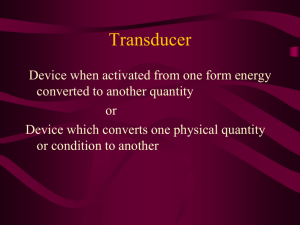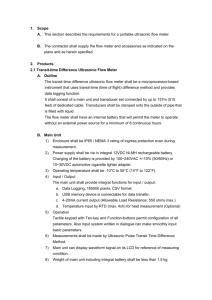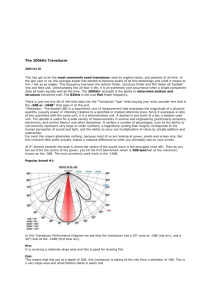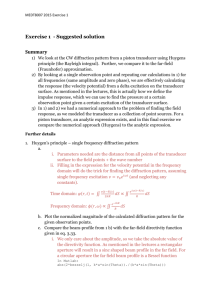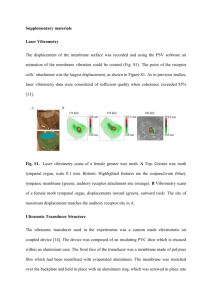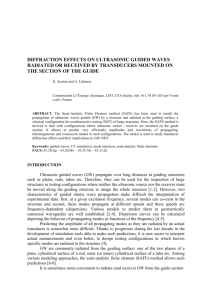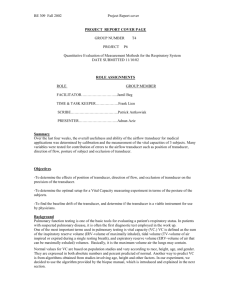HWset
advertisement
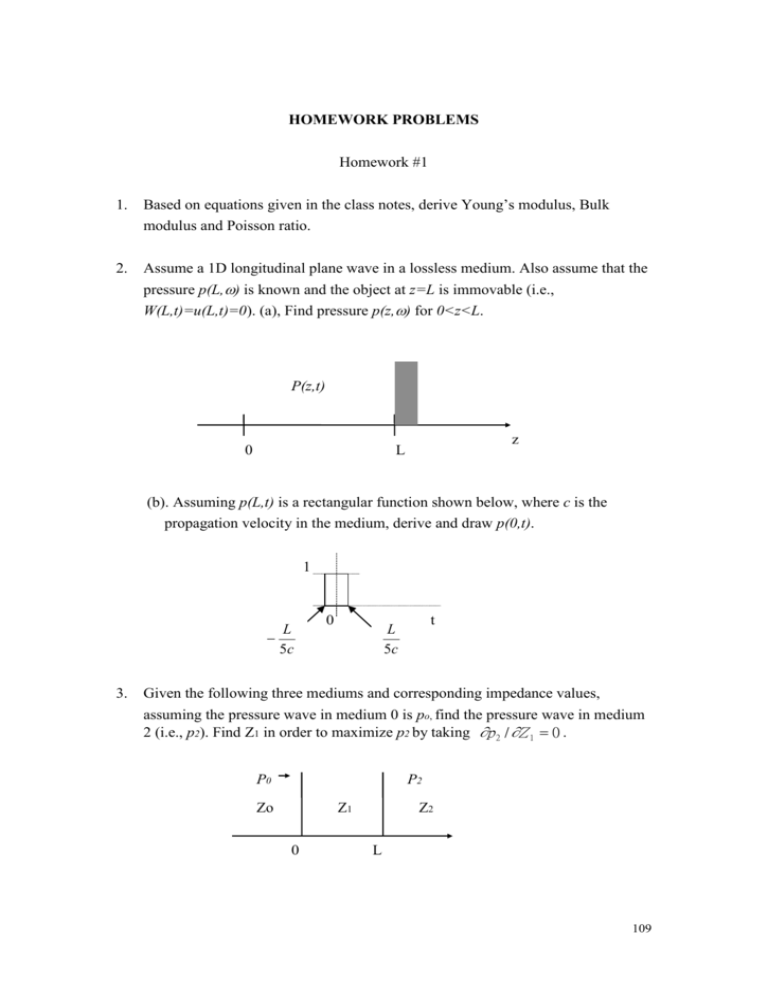
HOMEWORK PROBLEMS Homework #1 1. Based on equations given in the class notes, derive Young’s modulus, Bulk modulus and Poisson ratio. 2. Assume a 1D longitudinal plane wave in a lossless medium. Also assume that the pressure p(L,) is known and the object at z=L is immovable (i.e., W(L,t)=u(L,t)=0). (a), Find pressure p(z,) for 0<z<L. P(z,t) 0 z L (b). Assuming p(L,t) is a rectangular function shown below, where c is the propagation velocity in the medium, derive and draw p(0,t). 1 L 5c 3. 0 t L 5c Given the following three mediums and corresponding impedance values, assuming the pressure wave in medium 0 is po, find the pressure wave in medium 2 (i.e., p2). Find Z1 in order to maximize p2 by taking p 2 / Z 1 0 . P0 P2 Zo Z1 0 Z2 L 109 Homework #2 1. Assume the tissue attenuation coefficient is 0.5dB/cm/MHz. (a)Suppose the transducer is excited by a perfect impulse and the transducer’s 2 2 frequency response (power spectrum) is S ( f ) e ( f 4 ) (f is in MHz), what is the center frequency of a signal reflected from 10cm and received by the transducer? (b)Using continuous wave excitation and the simplified expression for scatter cross section in the Rayleigh region (i.e., s k 4 a 6 ) , find the optimum frequency in order to maximize the received intensity from 10cm. 2. In the class notes, we have learned that the standard deviation of speckle on a logarithmic scale is around 4.34 dB. What is the standard deviation if we modify the logarithmic function as the following I f ( I ) k 10 log10 , I0 where k is a constant ? How does the SNR ( SNR f (I ) ) relate to k (ignoring f (I ) all second and higher order terms in the Taylor series)? 3. Using the tables given in the class notes, design a transducer from PZT-5H with a center frequency at 3MHz. (a). What should the thickness of the PZT-5H layer be? (b). To insert a single impedance matching layer, what is its characteristic impedance value for liver imaging (ignoring sound propagation in skin, fat, …etc)? (c). Assuming the propagation speed of sound waves in the matching layer is 2500m/sec, what is the thickness of the impedance matching layer? 110 Homework #3 1. Suppose the sound velocity in tissue is 1500 m/sec and suppose a 128 element transducer array being constructed with a center frequency of 3MHz, an aperture size of 5cm, and uniform apodization. (a). Assuming the element width is about the same as the interelement spacing (i.e., w / d 1 ) and a continuous wave (CW) of the same frequency is coming from the far filed (i.e., assuming a plane wave), what is the angle of the first zero-crossing point of the one-way radiation pattern ? (b). Assuming the CW approximation is good for both transmission and reception, what is the angle of the first zero-crossing point of the round-trip radiation pattern ? (c) Based on the sinc table and conditions specified in (a), what is the -6dB beam width of the one-way radiation pattern ? (d). Given the conditions in (b), what is the -6dB beam width of the round-trip radiation pattern ? 2. For the same transducer array specified in problem 1, (a) what is the angle of the grating lobe when the radiation pattern is steered to 45o ? (b). What is the maximum steering angle without the presence of grating lobes ? 3. For the same transducer array specified in problem 1, ignoring the grating lobe effects, and using the CW approximation, (a). how many lines need to be fired in order to acquire a 90o pulse-echo image (i.e., a sector from -45o to +45o) ? (b). If the array is weighted by a hamming function (as opposed to uniform weighting), how many lines need to be fired ? Hamming weighting is specified as w = 0.54 - 0.46*cos(2*(i-1)/(127)) where i is the channel index (1 to 128). (c). If one out of two channels (channels 2, 4, 6, …, 126, 128) is inactive, how many lines need to be fired ? 111 Homework #4 1. Assume a sound velocity of 1500 m/sec and a 128 element transducer array (linear scan format) with an interelement spacing of 0.5mm and a center frequency of 5MHz. (a). What is the maximum delay quantization interval in a RF beam former in order to achieve fine focusing quality? (b). For channel 1, what is the time delay (relative to the array center) as a function of range? (c). Given the answers from (a) and (b), how many taps should be in the delay line shown below (as a function of range)? (d). Assuming the beam former hardware is limited such that there are only 20 taps available, how would you limit the aperture size (as a function of range)? input delay controller output 2. Assume that a transducer array (90o sector format) has 128 elements and / 2 inter-element spacing. Also assume that the imaging depth is 15cm and the beam spacing satisfies the Nyquist criterion. (a). Given a sound velocity of 1500m/sec, what is the maximum frame rate for a center frequency of 3MHz? (b). What is the maximum frame rate for a center frequency of 5MHz? 3. Assume that a lesion (an object to be detected) and its corresponding speckle correlation cell are both circular and can be characterized by diameters d l and d s , respectively. Also assume that the mean intensities of the lesion and of the background are D1 and D 2 , respectively. (a). Suppose the minimum CNR required to detect a lesion is 1, derive the equation for the threshold detection curve in the contrast detail analysis. (b). What happens to the curve if the spatial resolution improves? 112 Homework #5 1. Assume that PW Doppler is operated at 2.5MHz, sound velocity is 1500m/sec, and a vessel at a depth of 15cm is of interest. (a). What is the minimum PRI that can be used without range ambiguity ? (b). For the PRI given in (a)., what is the maximum velocity that can be detected without velocity ambiguity ? (c). Assuming blood is moving away from the transducer and no blood is moving toward the transducer, describe how you can detect flows with velocity larger the velocity specified in (b). Or explain why you cannot do so. 2. Assume that a transducer array (90o sector format for B-mode) has 128 elements, /2 interelement spacing at 3MHz and the B-mode display depth is 20cm. Also assume that the Color Doppler display area is from -30o to 30o and from 5cm to 15cm. If a [1 –2 1] wall filter is used and sound velocity is 1500m/sec, (a) what is the maximum achievable frame rate for the mean velocity estimation ? (b). what is the maximum achievable frame rate for the variance estimation ? (c). what is the maximum achievable frame rate for the energy estimation ? (d). If a 4 tap wall filter is used for better tissue rejection, what is the maximum achievable frame rate for the mean velocity estimation ? 3. Suppose the envelope of a signal used by a Doppler instrument can be described by the following equation a ( t ) e t . 2 (a). Find the slices of the ambiguity function for ( t , 0 ) 2 2 and ( 0 , f ) . (b). What is the time-bandwidth product ? (c). What is the time-bandwidth product if the signal is changed to a (t ) e t 2 2 ? 113
